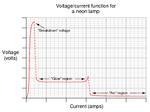Teknolog
Newbie level 4

- Joined
- Sep 1, 2013
- Messages
- 6
- Helped
- 0
- Reputation
- 0
- Reaction score
- 0
- Trophy points
- 1
- Activity points
- 35
A neon lamp acts as a voltage stabilizer. No current flows through the neon lamp if the voltage across it is below a certain voltage V0. When the voltage becomes V0 a gas in the neon lamp ionizes which allows it to conduct current. When the lamp is lit it will have the voltage V0. A neon lamp is connected in the circuit shown in the illustration. In this case, V0 = 60 V, R = 100 KΩ and C = 1 μF.
a) Find the time t when the neon lamp lights up. A logarithm may be part of the answer.
b) Determine the voltage Vc(t) as a function of time. Divide the solution into two parts:
before and after the neon lamp lights up.
I manage to find out a) that the neon lamp lights up at \[t = RC*ln(2)\].
For b) that the voltage \[V_{C}(t)=2V_{0}(1-e^{-\frac{t}{RC}})\] for \[t < RC*ln(2)\].
My question is how does one calculate how to determine the voltage over the capacitor \[V_{C}(t)\] when \[t > RC*ln(2)\] ?




